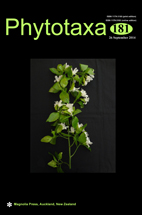Abstract
Research into the taxonomy of a novel cyanobacterial epiphyte in locations where birds, most notably Bald eagle and American coots, are dying from a neurologic disease (Avian Vacuolar Myelinopathy—AVM) has been ongoing since 2001. Field investigations revealed that all sites where birds were dying had extensive invasive aquatic vegetation with dense colonies of an unknown cyanobacterial species growing on the underside of leaves. Morphological evaluation indicated that this was a true-branching, heterocystous taxon falling within the former order Stigonematales. However, 16S rRNA gene sequence demonstrated that it did not match closely with any described genus or species. More recent sequence analysis of the 16S rRNA gene and associated ITS region from additional true branching species resulted in a unique phylogenetic placement distant from the other clades of true-branching cyanobacteria. Light, epifluorescent, and transmission and scanning electron micrographs confirm the novel characteristics of this species, which is true-branching form with uniseriate basal filaments. It is encased within a firm sheath and has heterocytes both within the filaments and at the tips of the branches. The species is in a new genus of uncertain family assignment, and is herein named Aetokthonos hydrillicola gen. et sp. nov.

